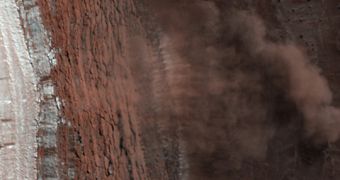While going through the large amount of pictures taken by the Mars Reconnaissance Orbiter HiRISE high resolution camera, a group of experts from the University of Berne, Switzerland, led by Patrick Russell have come across a series of photos showing a phenomenon strikingly resembling one happening on Earth. By the northern pole of Mars, the steep slopes sported an unprecedented event in the form of a dry icy avalanche.
Close to the foot of a half kilometer-tall cliff, wide clouds of snow and dust particles could easily be spotted. “We were looking at frosted sand dunes, and caught the avalanches in action,” explained Russell, quoted by Discovery. The winter season of the red planet traps carbon dioxide as ice and snow in large layers at its north pole. They can build up in layers up to 1 to 2 meter thick (3-6 feet) in the regions of the icy polar cap, while it can still grow to about 30 centimeters (about 12 inches) on the surrounding cliffs.
The large increase in sunlight that the spring brings determines the direct vaporization of the carbon ice and snow, without passing through the intermediary liquid form. This leads to the occurrence of avalanches 100 meters (about 330 feet) in width, racing down the cliffs at 80 km/h (about 50 mph). According to Russell, “If you were standing near the base of the slope, these things would be pretty impressive”. “These images show that there's more activity on Mars than we may have thought,” added Craig Kochel from the Bucknell University. “I don't think anyone thought about this at all too much before HiRISE.”
The similarity to the Earth's phenomena, especially to those going on in Alaska, is even more obvious since both kinds of avalanche are “dry”. But on Mars, they are made mostly of fine snow and dust particles, while on our planet, they come in large blocks. The terrestrial gravity and atmosphere also cause the avalanches to be more noisy and devastating, while the red planet's three times weaker gravity and the atmosphere thinner by a factor of 100 don't allow for such startling events to happen. “The avalanches we're seeing wouldn't have nearly as much oomph as ones on Earth,” shares Russell.

 14 DAY TRIAL //
14 DAY TRIAL //